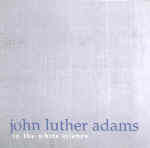John Luther Adams (not to be confused with John Adams) writes what might best be called “eco-music”, often inspired by the vistas of his native Alaska. That means lots of emptiness and desolation, and my colleague Victor Carr Jr. castigated an earlier disc of shorter works where the music essentially consisted of patterns devoid of significant content. That’s the danger inherent in any hermetically sealed style such as this, but the fact is that Adams works best on a larger canvas, and In the White Silence, where Morton Feldman rubs shoulders with Alan Hovhaness, should win the composer many friends, for it’s a gorgeous 75 minutes of meditative stillness.
The form of the work, such as it is, is simple. A string orchestra plays soft tone clusters (the composer calls them “clouds”) out of which emerge a series of lovely, modal episodes for string quartet, harp, celesta, and tuned percussion (vibraphone and bells). And that’s basically it; the two types of music alternate quietly over the length of the piece, each recurrence subtly varied but never dramatically so. It’s more like a slowly revolving sculpture or mobile than a linear progression in time with a beginning, middle, and end. For that reason you can “visit” the music for as long as you like; there’s no reason to sit through the whole thing if you don’t feel like it. But taken on its own terms the piece perfectly evokes the meaning(s) inherent in its title, and the feeling of time suspended actually does make listening to the whole disc surprisingly easy. In short, the music delivers the goods.
The performance, by the Oberlin Contemporary Music Ensemble, presents the music with complete idiomatic confidence–in other words, the players simply let the thing unfold without drawing unnecessary attention to themselves or to the mechanics of performing it. New World’s sonics capture the work beautifully, but like much of Feldman’s music, you should play it quietly–not at the threshold of audibility, mind you, but at a less aggressive level than usual. You’re looking for atmosphere, an aural landscape, and not in-your-face immediacy. Anyone coming to Adams’ music for the first time should start with this disc, for it really does make the best possible case for his personal artistic vision.
































